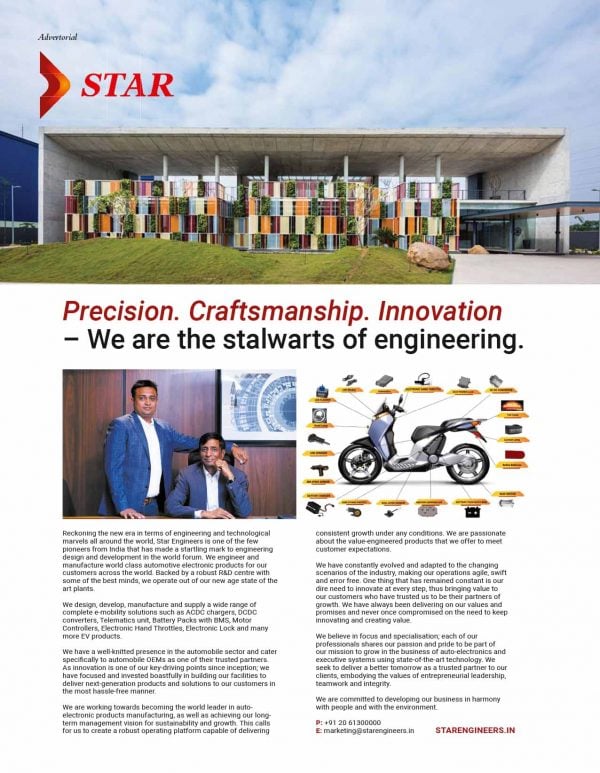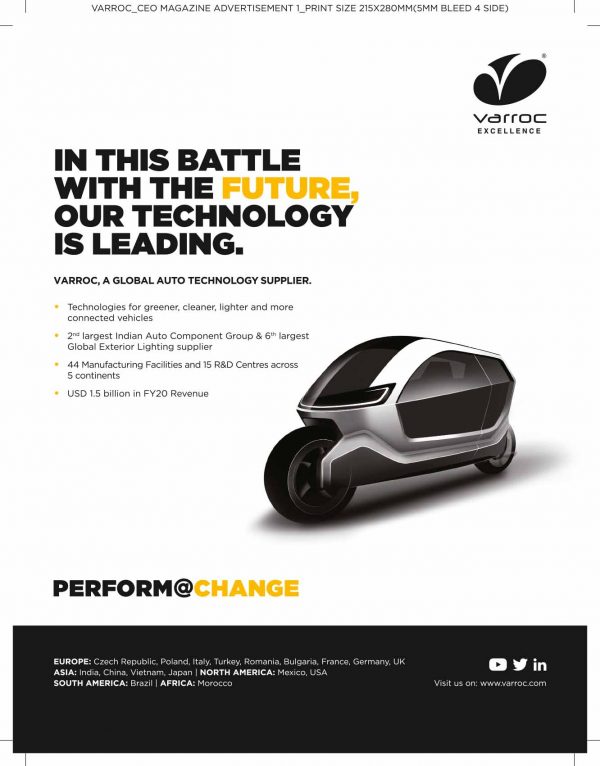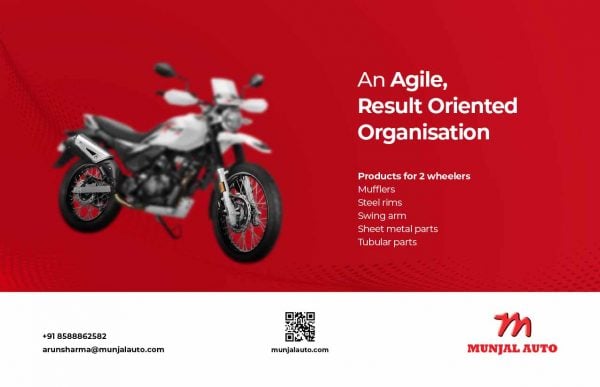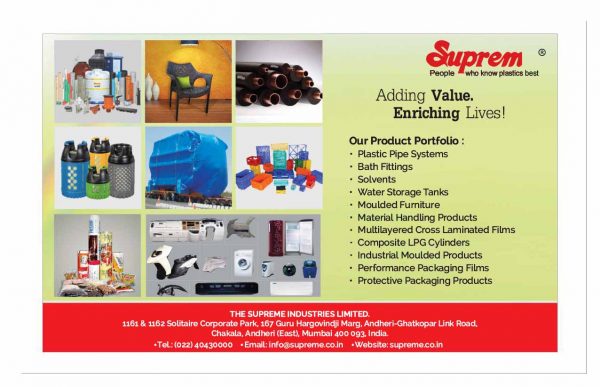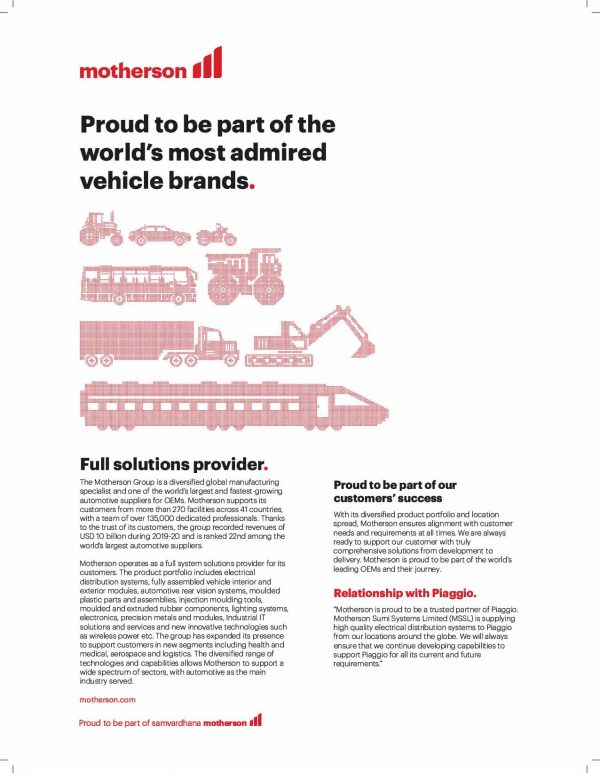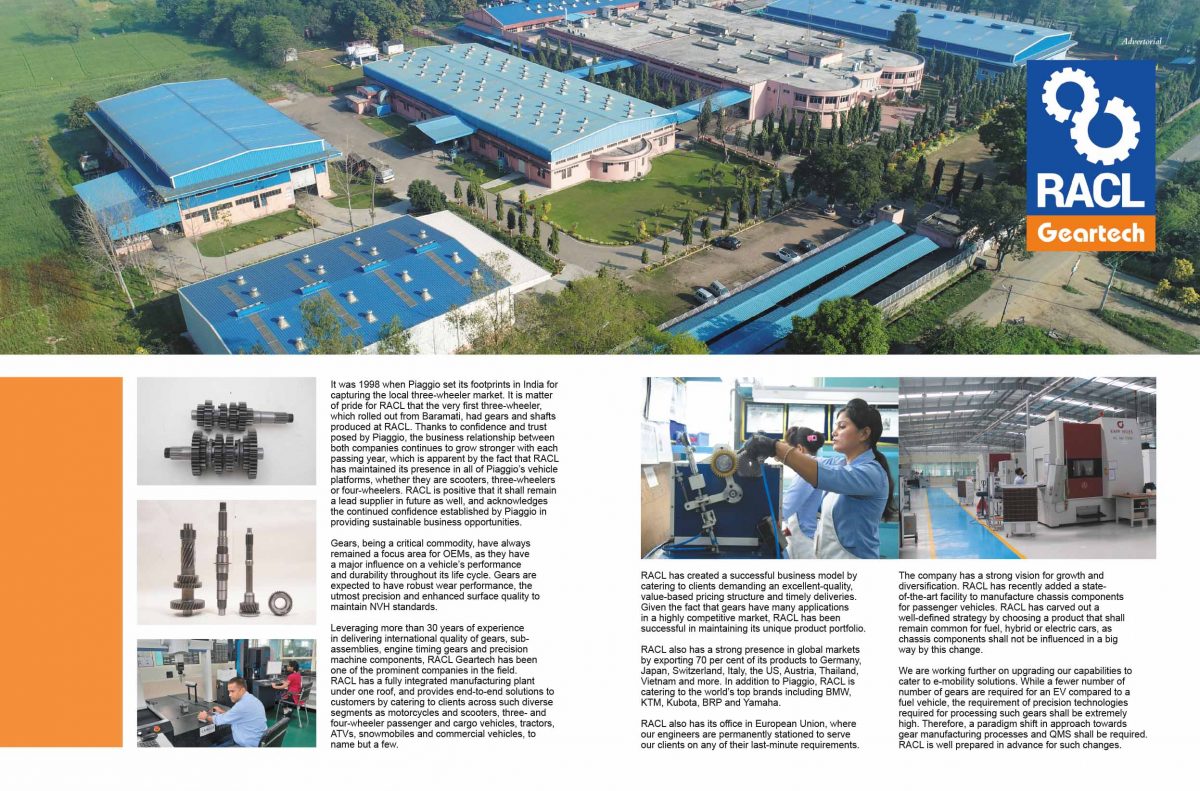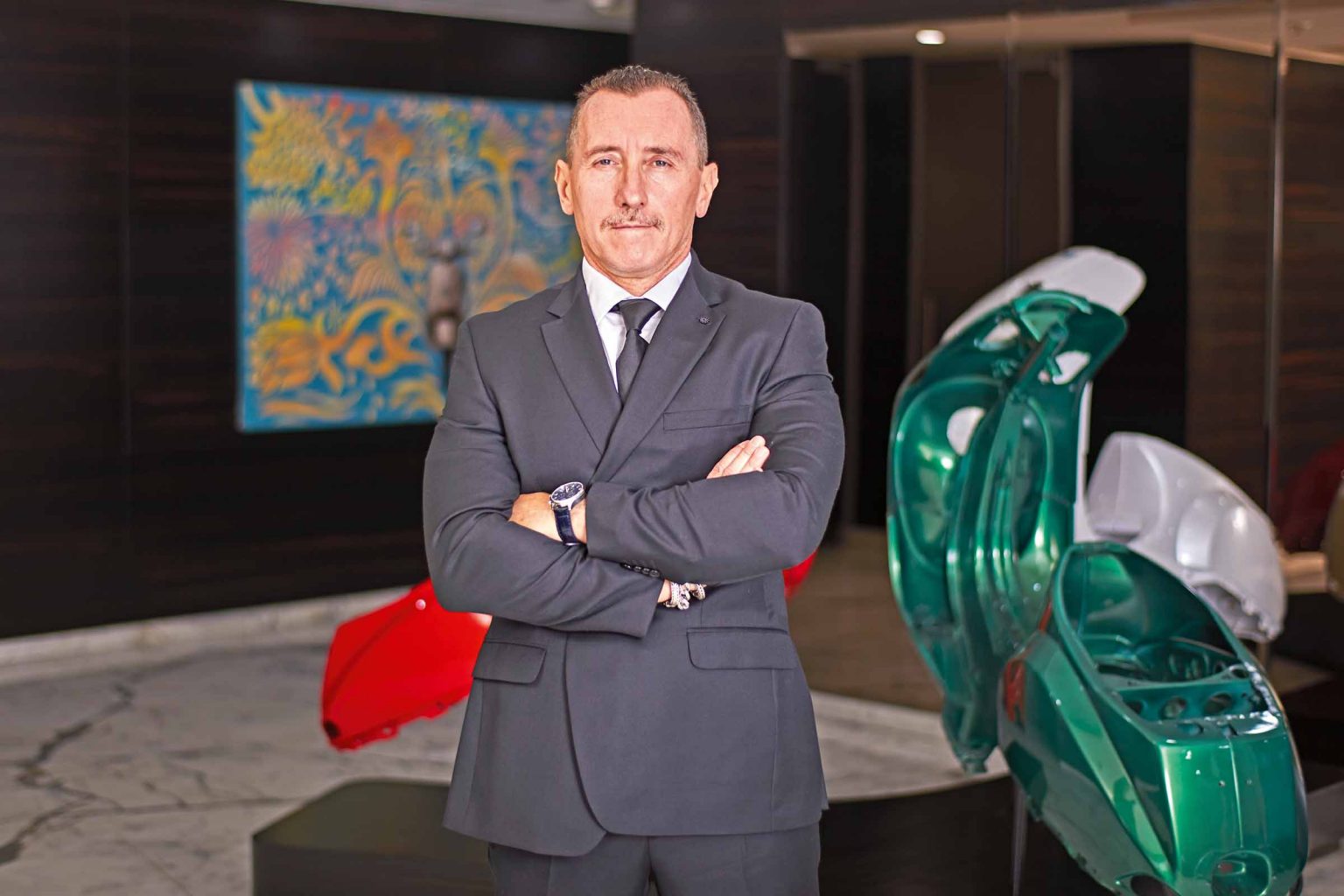The plasma that pulses through the arterial roads, streets, highways and byways of India’s cities has a sound and fury unique around the world. Sometimes red, often blue and even yellow on occasion, the Piaggio Apé is the lifeblood of some of the busiest cities in the world.
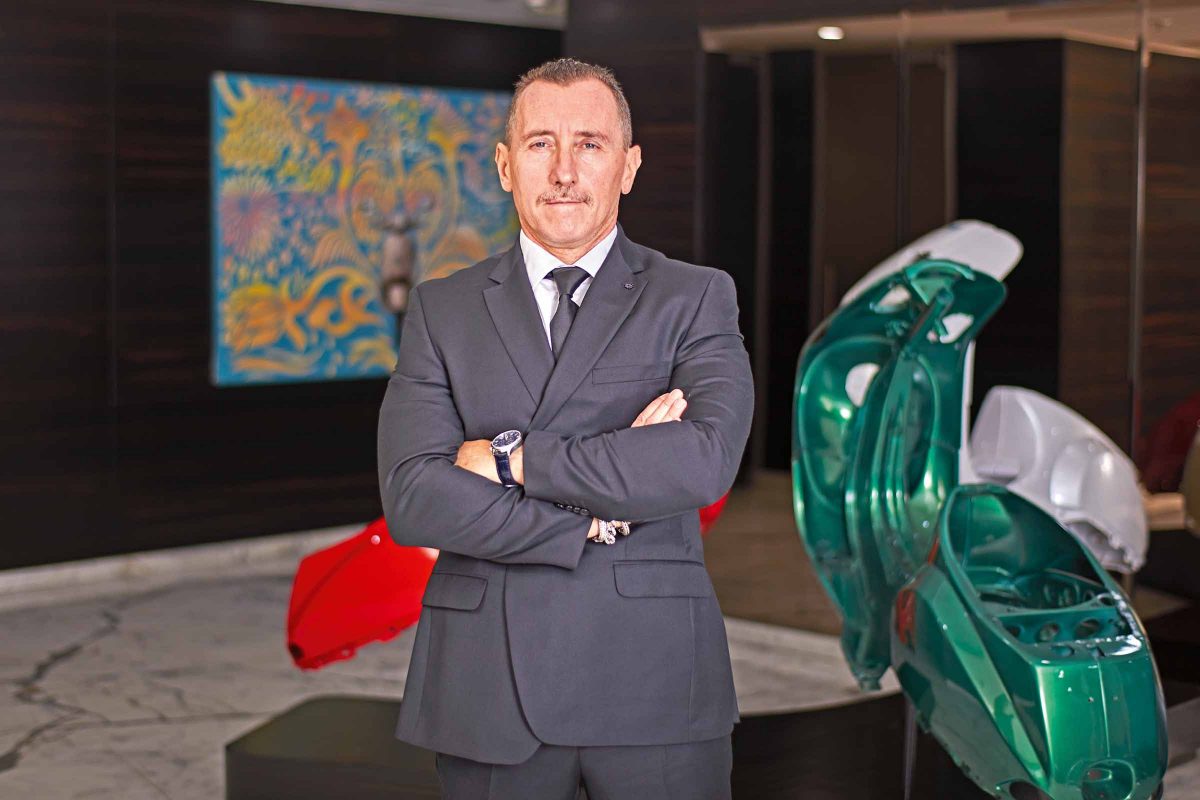
Despite its Italian heritage, it’s Indian made. The modern and versatile Piaggio Apé is India’s last-mile transportation of choice: ecommerce, taxi, street food vendor, courier and much more. Even the COVID-19 pandemic that has devastated much of the country has not been able to stem the flow.
Piaggio Apés are still running wild through crowded streets, carrying people and goods to wherever a three-wheeled vehicle is able to get to. Considering its size and dexterity, that is a lot of places. The size and agility of the Apé’s manufacturer Piaggio has also done much to place the domestic cargo carrier all over the country.
Currently, the Italian manufacturer and European market leader enjoys a commanding 42% share of India’s growing three-wheeler cargo market. It is fitting, especially since the Piaggio Apé is the ‘world’s original three-wheeler’.
Style council
“We’re the originator,” says Diego Graffi, Chairman and Managing Director of Piaggio Vehicles, the manufacturer’s Indian subsidiary. “We invented the Piaggio Apé in 1948 for goods and passenger transportation, and the style was then adopted by all the other players. But what the others don’t have is the strength of the Piaggio brand. That’s a huge advantage.”
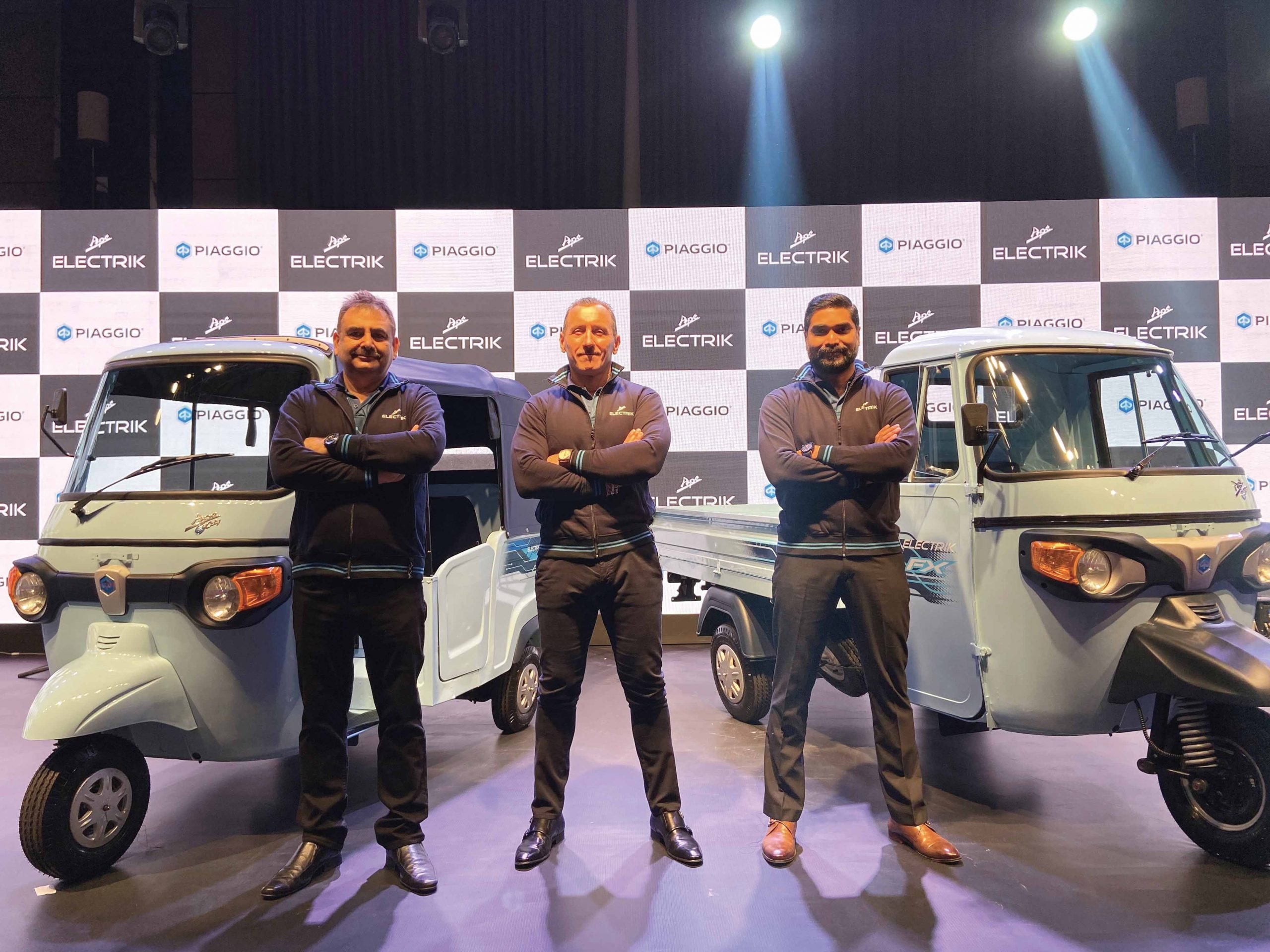
The road to Indian ubiquity has been a long one for Piaggio. The company launched in the sub-continent in 1999 bearing the Piaggio Apé as its standard. The market soon discovered it was a perfect way to navigate the frenetic pace of India’s city streets, and the power trike became a hit.
The company’s Vespa has also set the pace for the global two-wheeler market. Created as a stylish and affordable vehicle for the post-World-War-II Italian market, its popularity exploded in the 1960s when it became a style icon. Today, Vespa is a household name worldwide with strong brand recall in India where the two-wheeler business is picking up as well.
Indian summer
A mechanical engineering graduate, Diego got his start in the industry with Fiat Automobiles in Torino, Italy. “I was there for nearly 10 years,” he says. From there, he joined motorcycle company Moto Guzzi, which was acquired by the Piaggio Group in 2003.
“That was my way in, as a purchase manager. I ended up leading my group, with the last five years in a purchase environment.”
What others don’t have is the strength of the piaggio brand. That’s a huge advantage.
By 2012, he was Global Purchasing Head for the entire Piaggio Group, a role that included a short, eight-month stint in India. In 2017, Diego was invited to head up the Indian subsidiary on the condition that he transform the company’s public image in the country.
“I had to do it not just from a product point of view, but also in terms of culture,” he reveals, adding that Piaggio didn’t have the kind of renown from those outside the organisation necessary to tackle the market leaders. “We were struggling quite a bit to convince people to join Piaggio,” he says.
“I started from scratch. I had to create competencies nobody could convey to me,” he recalls. “But I wasn’t left alone, because luckily I had the support of the team here.” In fact, one of the strongest assets the company has, he says, is the level of skill among its staff.
“That helped me quite a lot during my early days.” At the same time, Diego says he had to reinvent himself to take on the role. His nine years as Global Purchasing Head for Piaggio was “a lower level of responsibility” than the new role before him.
If you want to compete you need to seize opportunities, whatever they are. And that means you have to think differently.
“The opportunity to head up Piaggio Vehicles, to become Chairman and Managing Director of an important company of 3,000 people with a US$500 million revenue, was huge,” he admits. “And given where I’d come from, it was a big change.” Luckily, Diego wasn’t a stranger to India.
“I’d visited many times since 2007. I knew the market, the culture, the way of working; it wasn’t new to me,” he says. But the biggest difficulty Diego faced in his new position was Piaggio’s two-pronged approach to the Indian market.
“On paper, the company is one. In reality, we’re focused on two different businesses: three-wheeled small commercial vehicles and two-wheeled scooters,” he points out. The Apé had made Piaggio the leader in the former.
“The mentality and business attitudes when dealing across these two threads are completely different,” he says. “You have to somehow change your mindset when shifting from the needs of the three-wheeler market to the two-wheeler market.” However, if this task was a worry for Diego, he doesn’t show it. Instead, he’s put quality over quantity.
“We’re not aiming for a mass consumer segment like all the other players in India,” he explains. “With two-wheelers, we want to be perceived as a premium player in a very specific segment of the market.”
Planet of the Apé
By changing the goalposts and embracing Piaggio’s status as a premium brand, Diego was freed up to innovate. For the manufacturer’s flagship three-wheelers, that means what he calls a “fuel-agnostic philosophy”. For every product line in the three-wheeler business, customers are able to select their preferred powertrain.
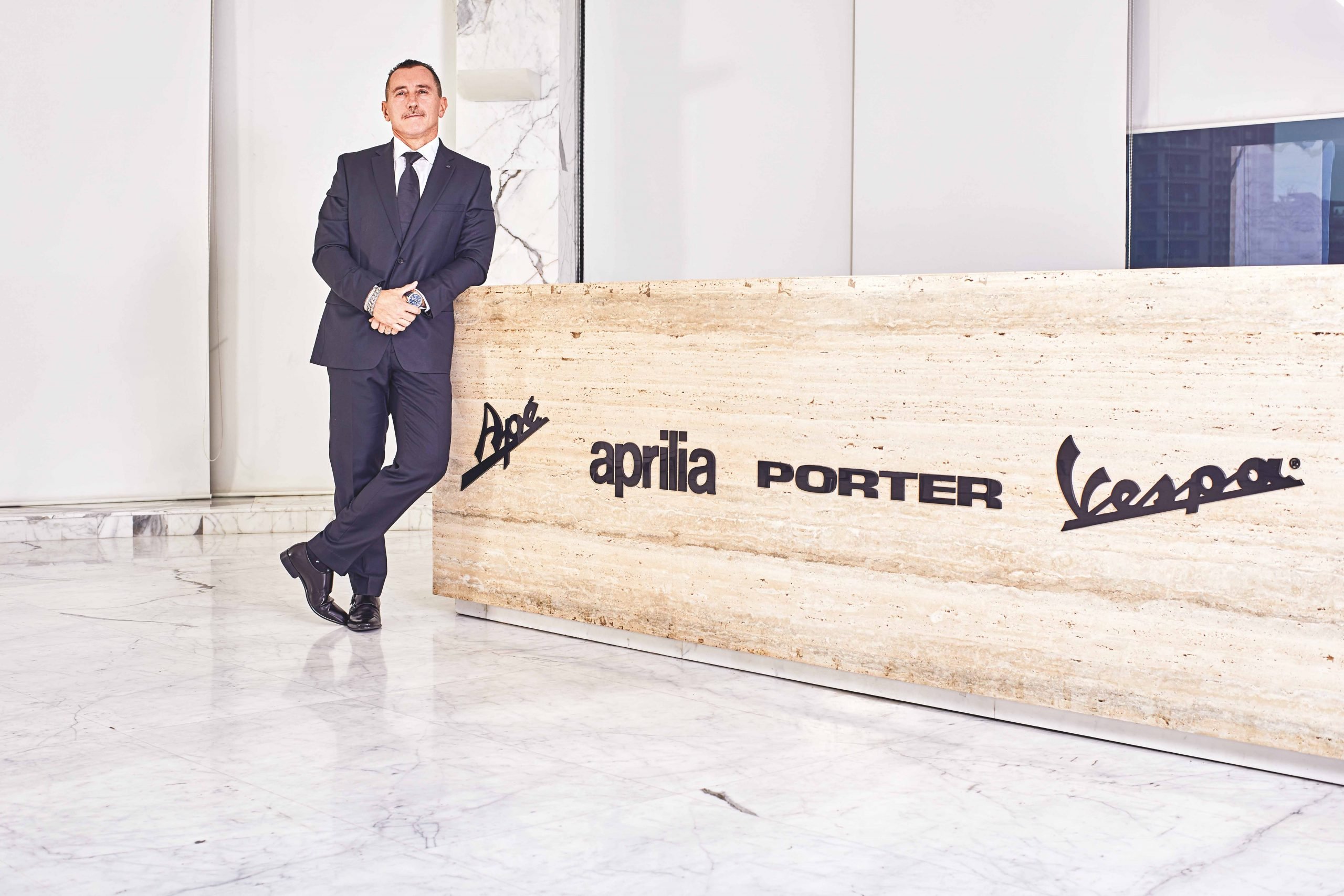
“Whatever their needs or business environment, we want to give customers the choice,” Diego says. “Whether it’s diesel, petrol, electric, CNG or LPG, we’ll make it possible, and that will give us the ability to compete.”
The fuel-agnostic policy, first announced in 2017, has enjoyed a full three-year development cycle. In the wake of the COVID-19 pandemic, fuel sustainability has become a focus for the Indian government. Electric vehicles are the obvious solution, and mass adoption of the technology is the goal.
“Electric is on everybody’s lips when we talk about the automotive industry. That’s not only in India either, but across the globe. We know that the future of the industry is electric. As an OEM, you must offer electric vehicles or you’re out of the race,” he stresses. The government’s push for electric solutions helped Diego form Piaggio’s strategy, as did his understanding of the Indian market.
“Everybody here is pushing OEMs to convert to electric,” he confirms. “That’s the central government, the local authorities, every kind of agency, the Minister for Road Transport and Highways Shri Nitin Gadkari, the Prime Minister’s office, everybody.”
Diego says Gadkari’s support was particularly encouraging. “At the launch of our swappable battery Apé electric, the minister told me he believed the future of the three-wheeler in India is electric.” To underscore the commitment, the Delhi government began building 100 vehicle battery charging points across the state in February 2021.
Heading up Piaggio’s initiative will be the new Apé Electrik range. This includes the Apé E-City, which features swappable smart batteries provided by local energy company Sun Mobility.
The swappable batteries have been designed to lower the Apé E-City’s up-front purchase cost, and can be swapped at Sun Mobility interchange stations. Alternatively, the Electric FX range features fixed batteries.
“The swappable batteries are like a rental model,” Diego says. “Whenever they get exhausted, you don’t have to wait five hours for a recharge. You just go to a swapping station, swap your exhausted battery for a fresh one and you’re off in two minutes.” POWER AGE Diego takes the challenge of electric vehicles very seriously.
“In fact, I wanted Piaggio to be the first player in India to launch swappable batteries as it’s the kind of confidence that can remove roadblocks in the minds of consumers about whether or not to adopt electric vehicles,” he says. He believes those roadblocks are range and high prices; the swappable batteries are a direct response to high prices, while Piaggio’s fuel-agnostic range provides options.
“Even though we were the first company offering this technology in the three-wheeler space, it’s an opportunity to change the industry,” he acknowledges. Diego is confident the range will be completely ready for market by the end of 2021.
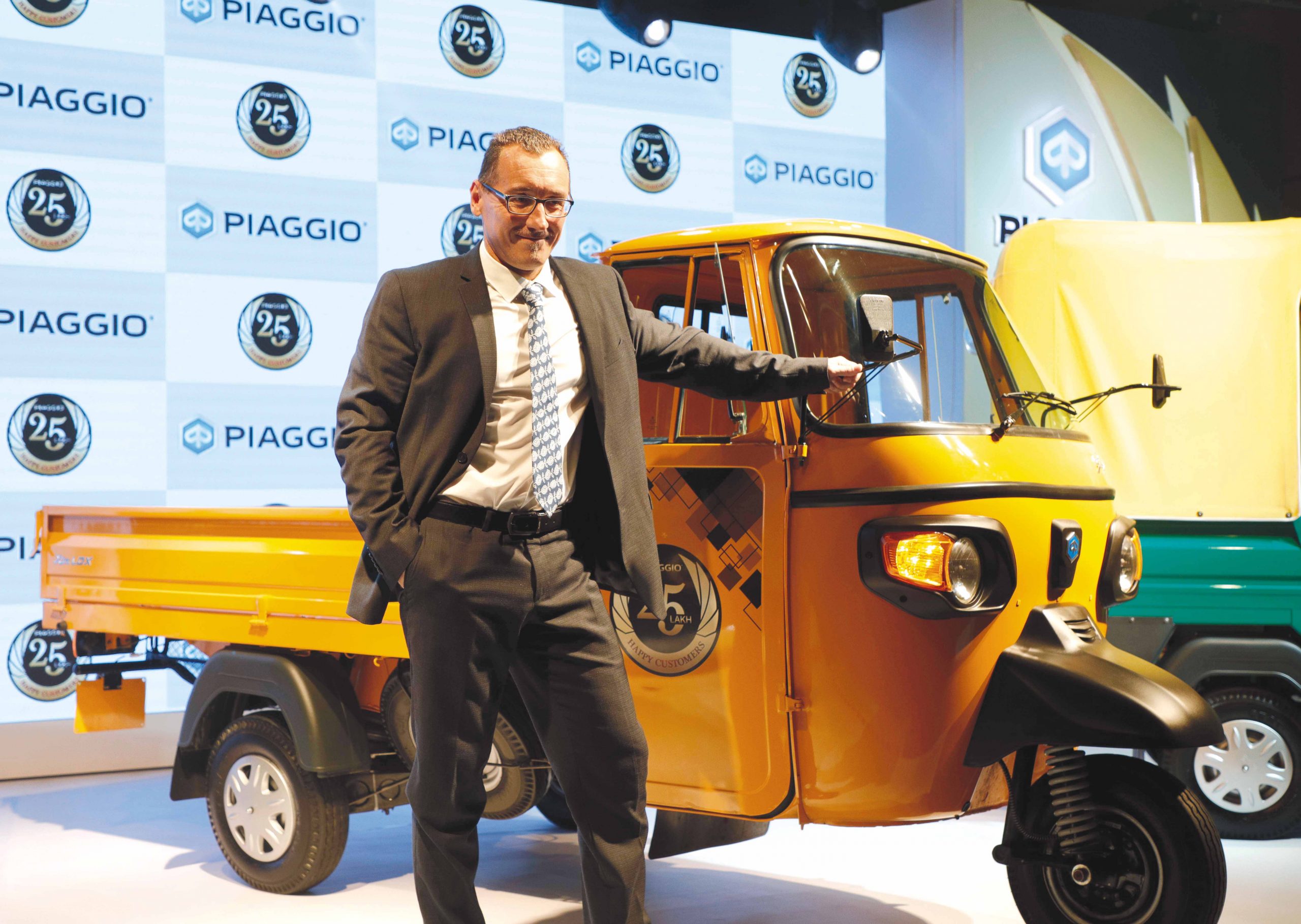
“It’s been a big investment for us, and we want to take advantage by catering to changing needs not just across India, but also throughout the international market,” he says. It is the latest development in the strengthening relationship between Piaggio and India.
In 2013, the company announced that Piaggio Apé production would shift in its entirety to India. “I think the biggest challenge Piaggio has had in India was the introduction of the Bharat stage emission standards. To go from BS4 to BS6 in 2019 in particular was tough from both a technical and a cost point of view,” Diego concedes.
The company’s full presence in the country meant the technical side could be achieved in time (“We were far more prepared than the Indian government’s guidelines required,” he insists), but he admits the cost of that transition still affects production. The upside was a strengthening of relationships with local organisations united for a common goal.
“We all contributed, and I know that helped us very much. We succeeded, and that year, we increased our market share pan-India and increased our penetration into a segment where we weren’t as present before,” he says proudly.
New landscape, new challenges
“The challenge I see going forward is to identify the possibilities for improving efficiencies that can help us maintain acceptable prices for all customers across two- and three-wheelers,” Diego reflects.
“The price increases of commodities we’ve seen over the past year are most definitely not helping, but I believe that is only a temporary phenomenon.” The COVID-19 crisis has hit India harder than most countries, and Piaggio hasn’t been immune from the fallout. “Last December, we thought it was nearly over,” Diego admits.
We know that the future of the industry is electric. As an oem, you must offer electric vehicles or you’re out of the race.
“We’d had complete shutdowns in April and May of 2020, but from June we were able to restart.” When the second wave hit in early 2021, the situation in India became among the worst in the world.
“There is fear at the retail level, with a drop in sell-out enquiries across the country in the past few weeks. So, not only do we have to somehow restart again from where we’d already restarted mid-2020, we also have to re-create the same mood of positivity as we enjoyed last June,” he explains.
According to Diego, employee engagement is among the biggest hurdles, with work-from-home orders looming once more. “Right now, there’s no strict lockdown. Manufacturing units are operating, but demand has dropped, and the fear of another lockdown is there in the customer base,” he shares.
“We have to motivate our staff, keep them committed to the business, and have more of a mid- to long-term view, because the short-term is definitely not going to be positive.” The next two or three months will be crucial from a business point of view, Diego adds. “If you want to compete you need to seize opportunities, whatever they are. And that means you have to think differently.”
Thought leadership
During the first lockdown, Diego saw a use for all the time he and his executive team suddenly had on their hands. “Management only grows in terms of competency and motivation as a result of investment from the leader,” he says.
Throughout those two months of lockdown, Diego personally took the time to provide his executives with training on design thinking, and lean thinking from some of the top coaches at an international level. “I think these two methods are fundamental to compete in the post-pandemic ‘new normal’,” he predicts.
“You have to think lean because every rupee counts now, and you have to think differently because it’s a different world that will require a completely different business attitude.” But it’s not all doom and gloom.
“The experience I had here last June, when we opened up again, was amazing,” Diego beams. Before the pandemic, his efforts as CMD had turned Piaggio into an in-demand employer. “People were spontaneously applying for jobs with us, even if we didn’t have open positions.” Piaggio offers new recruits the chance to add value to their careers.
“They can develop their skills, their competencies, they can develop as a profession,” he says. “We’ve become a company people dream to work for. I drove that change across my first four years. We made an effort to change the culture and to change the market’s view of us, and it worked.”
When the first wave of COVID-19 subsided and production started up again, this enthusiasm hadn’t abated. “Across the entire organisation, people were keen to come back to work. This was the best demonstration of the affection people had for Piaggio,” Diego smiles. A year on, he believes the same result can happen again.
“We’ve got a lot to do. We have to maintain positivity among dealers, customers and staff,” he admits. “We’ll be heavily investing in digital to connect with our customers, but the advantage we have is having gone through it all last year. We have the advantage of experience.”
Howdy partner
Partner relationships, another vital piece of the Piaggio network, have also been tested by the extremes created by the pandemic. With his background in the company’s purchasing division, Diego knows Piaggio’s vendors; indeed, he built the supplier pool during his decade as Head of Purchasing.
“That really helped during the past 12 months because it allowed me to lean on a strong supply base that excluded us from the supply chain difficulties others were experiencing,” he explains. Piaggio’s network of suppliers spans India, China and Vietnam, and supplies to all the companies in the group.
“At the same time, our three main manufacturing hubs are in India, Vietnam and Europe, so there’s a bit of crossover in our supply base,” he says. “We see these vendors not as simple suppliers, but as partners. They help us to develop our products, to take advantage of the innovations available to us in the market and to cross-fertilise this range across the group.” When operations rebooted in June 2020, Piaggio’s partners were ready to deliver.
“We didn’t have to restart from scratch,” Diego recounts. “Our partners were strong enough to survive.” It’s not simply an ability to supply – or survive – that makes a company one of Piaggio’s most important partners, Diego insists.
“If you are capable of anticipating innovation that you can propose to us before our competition gains a similar advantage, that is critical,” he stresses. “You have to be able to supply the same part all over the world. Piaggio has at least 20–30 suppliers able to meet both of these criteria, and that’s an edge.”
The BS6 transition was a perfect example of a supplier providing innovation on cue. “We have a special relationship with suppliers who specialise in electronics, as many of our vehicle components are now linked to electronic development,” Diego says.
“The BS6 transition required our scooter engines above 150cc to be converted to full electronic fuel injection systems. Thanks to our supply base, we were able to make that switch immediately.” Though difficulties arose from a dearth of raw materials and sub-components, the Piaggio supplier pool helped the engine kick over.
“Once normal conditions return, volumes will pick up quite fast in those areas,” Diego asserts. “Simply being able to smoothly return to business has given us an enormous advantage.”
Electric dreams
When Piaggio did return to a hungry market, its healthy network of dealers was ready to catch what came off the assembly line. In India alone, its network numbers more than 725 dealers. With the advent of the electric fleet, the manufacturer has introduced its ‘Electric Experience Centres’ designed to further tackle consumer roadblocks.
In May this year, Piaggio opened a further 100 dealerships in 100 days to keep its new range within reach of customers everywhere. Although India is the fifth-largest auto industry, the country’s commercial passenger vehicle market is in decline. A younger population is driving growth in the two- and three-wheel sector year on year.
“Our long-term plan is to consolidate the growth we enjoyed in 2018–19, not only in terms of volume, but also product gamma evolution, and presence in international markets with our products,” Diego reveals. That includes Piaggio’s scooters, which he admits are a niche product in India.
“We started with Vespa in 2012 and introduced the Aprilia brand in 2016,” he says. “I think it is the best two-wheeled product line anyone could hope to have in India. We want to increase our presence, but we will always remain faithful to our philosophy of being a premium player.”
It is the three-wheeler game that Piaggio hopes to continue to win, and the new line of the Piaggio Apé is well placed to make the most of a market struggling to return to normality.
“We want to consolidate our presence and be consistent. We are targeting 2022 and 2023 for market revival,” he adds. Over the next 12 to 18 months, Diego believes that normalcy is achievable as the market recovers.
“When it does, we need to be ready for that moment,” he maintains. To keep things running in the meantime, Piaggio is looking at a variety of options, including a renewed focus on exports to neighbouring Nepal and Bangladesh, where demand has increased sharply. The growth of Piaggio India seems to run in tandem with the world’s awakening to a streamlined vehicle industry.
The mobility and convenience offered by two- and three-wheeled vehicles over traditional cars is a major factor, while the worldwide shift to alternative fuel sources has breathed new life and new innovations into the market. At every step of that journey, Piaggio has been at the forefront, and as trends continue to evolve and solidify, that seems likely to continue.
“I think Piaggio is very well placed, not only in India, but also around the world,” Diego says. “Our product portfolio puts us far ahead of any other competitor, and our partnerships keep us there. The stronger the dealer network you have, the better equipped you are to compete. We have the competencies, network and experience to do so.”
Proudly supported by:
